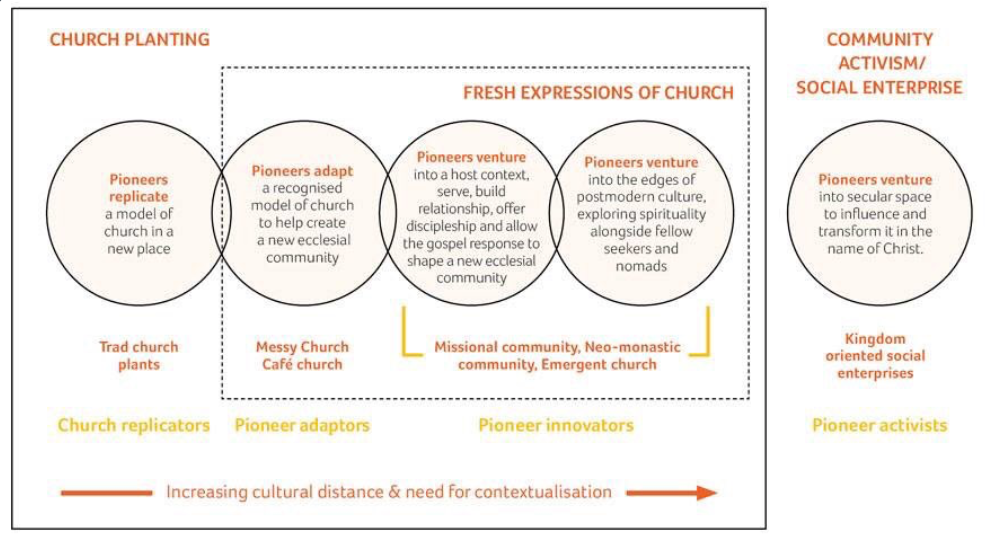
It seems that gardening is becoming a theme here. Planting has often been problematic. You have to have the right conditions. The soil needs to be just right. You need to provide nourishment, and support the hopeful growth when it comes. Pioneering is an alternative approach.

When we talk about church planting I think the analogy can sometimes fall down – bit like the runner beans in high winds. Ever since the initiative of #FreshExpressions (1990s) was created ‘planting a church‘ has been the favoured mission option. This could be understood as a ‘cutting’ of the main church being ‘taken’ and ‘rooted’ in another, hopefully fertile, area. Resources, people, would also have to be involved to support the new ‘plant’ as it grew.
Planting Church
Have you heard of the ‘Alpha’ course? If so, its originators, Holy Trinity Brompton Church in London, have always been a great instigator of church planting. New Wine, an evangelical church organisation, have devised a set of key people: dreamers, who engage with the mission; doers, who build from scratch; donors, who help financially; and ‘don’t knows‘, who are the vocal supporters, the interested and intrigued.
Traditionally, planting is the replication of a church from an already established congregation.
(see graphic below)

However, planting a church can be about reaching the ‘unchurched’ or ‘dechurched’. These labels * may not be helpful, as they can marginalise people. We all need God.
There is an alternative approach.
It is in the small groups that can emerge which can permeate throughout society and make that change – and be the catalyst.
Pioneering a new expression of church
Pioneering is a calling for those with a vision to go into a new context to give birth to a new God-centred community.
Are they the same?
No, I don’t think so. Planting, according to Stewardship.org, requires structure, considerable infrastructure planning and substantial financial backing (see Page 14). Pioneering is more risky however. It’s not focussing upon creating a replica of the past or present. But contextually seeks to ‘find the Christ in the other‘. Pioneering is going and staying within a community. It re-discovers that God is in that community, and can be a catalyst for change.

Einstein purportedly said that “insanity is doing the same thing over and over again and expecting different results“. Pioneering is about going beyond the fringes of the ‘church’ and ‘being’ there. Pioneering is an alternative approach – it’s the change which may be needed.
The word ‘pioneer’ is only found in the New Testament on four occasions, [the word is archegos: once in Acts and three times in Hebrews] all applicable to Jesus, where it is the first occasion or they go into a new space. (Hebrews 12:2)
Location, Location, Location…
If we are talking about a ‘new space’ then previous posts about the ‘third place‘ also apply. Rather than looking to enter a church building, we can go where people find it comfortable, relaxing, where they can become vulnerable: “to be open” is what may be needed. This location may also need to change – we need to remain contextual.

The wonderful Hidden Harvest material says that evangelism and discipleship can be seen as equivalent, for then community can be developed, and then worship. Worship is one aspect of our post-Covid drivers to get back into church. Methodists were “born in song“ is an oft cited phrase. However, that desire to express our faith in ways that would also resonate with Wesley must also be paramount: being with the people.
How do we give opportunity for others to see what excites us about our faith?
Dialogue, Participation – it’s all here
How can we meet: informally – with interactive dialogue, to foster community – so needed post-Covid; invite participation for all from the outset; and share stories? Rather than the didactic teaching style traditionally employed, perhaps this approach of: being with people, in their situation, understanding their circumstances, might allow our enthusiasm, our passion that we express about our faith to be seen, heard, and felt. Pioneering is an alternative approach.
Hence, my opinion is that pioneering is a preferred way forward. Thus being with the people, allowing this new community to grow together, where we understand ‘our’ opinions rather than focus upon the churches’ opinion.
It was Jesus who didn’t seek to conquer the Roman Empire, nor create Christendom. He started with ‘the Twelve’, who spoke about the leaven and the ‘yeast’.
It is in the small groups that can emerge which can permeate throughout society and make that change – and be the catalyst.
So what now?
Church Planting, as an expression, was already in 2004 considered possibly passé. There was already discussion of the need of a ‘mixed economy’. From ‘planting’ to ‘fresh expressions’, we can move towards ‘pioneering’ as the in-vogue term. What may be desired now is a focus upon the freedom that this allows. No longer seeking to reproduce the mother church DNA into the new church, but delighting in the fluidity of what might be.
The Church is changing and will continue to change – I hope and pray. Here’s the dream of less conformity, and more fluidity:
What are your thoughts? Is it dependent upon context, your location, whether we ‘plant’ or ‘pioneer’? Or are they, in principle, the same? I’d love to hear your views.
References(*):
- Philip J. Richter and Leslie J. Francis, Gone But Not Forgotten: Church Leaving and Returning (Darton Longman and Todd, 1998)
The diagram you show is from Tina Hodgett and Paul Bradbury, ‘Pioneering Mission Is a Spectrum’, ANVIL: Journal of Theology and Mission, 34.1 (2018) and also included in the book Paul Bradbury, Home by Another Route: Reimagining Today’s Church (Abingdon: The Bible Reading Fellowship, 2019)
Thank you Andy for this information which I have duly added to the blog. Great to make contact with you.